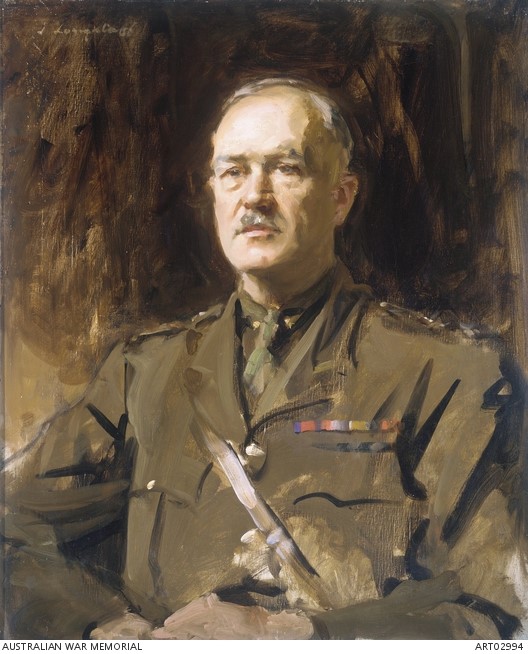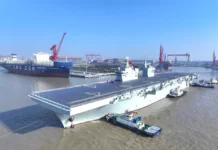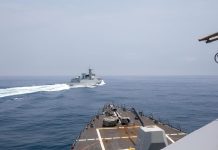
By constant care: health support for RAN operations 1900-1976[1]
By Neil Westphalen*
The RAN’s military, diplomatic and policing roles have furthered Australia’s world-wide national interests in peace and war since 1911. These roles explain why, rather than having treatment services as an end unto itself, it needs health services that are actively focused on getting its ships to sea and keeping them there. Furthermore, the RAN routinely performs these three roles throughout a spectrum of conflict between peace and war. This explains why, unlike Army and RAAF (for which conflict has until recently been a binary ‘on/off’ switch), it needs the same health services throughout this continuum.
Yet, there are no military health strategic theorists comparable to Sun Tzu regarding continental, Mahan regarding naval or Mitchell regarding air power strategy, to guide how this should be done. The closest, Arthur Graham Butler, concluded that military health services have what would now be called three co-equal but interlinked ‘missions’: to provide treatment services, facilitate their commander’s operations, and enable civilian transition. However, his conclusions are incomplete and have since been forgotten. This has led to the ADF’s health services mostly focusing on providing treatment services for wartime battle casualties. The ensuing shortfalls have been demonstrated by a 10% decline in personnel deemed fit for sea since 1996 (nine Anzac crews), and the 2024 Royal Commission into Defence and Veteran’s Suicide.
Colonel A.G. Butler, 1918
The history of the RN’s health services suggests this has not always the case. Although English shipmasters had been responsible for finding accommodation for sick crewmen and paying for their treatment since 1194, they were often unable to find them when and where they were needed. By 1653, a succession of escalating medical failures ashore led to the first of five wartime-only Sick and Hurt Commissions, with the last of these becoming a peacetime Board in 1714. Having initially used civilian contractors to provide treatment services and accommodation (typically inns and pubs), the Commissions soon found that civilian hospitals provided better and cheaper care. However, these began to refuse naval patients because they stayed longer than civilians. In addition, the Commissions had problems with drunkenness, desertion and other disciplinary problems among naval convalescents. In response, the RN built its own hospitals and staffed them with its own health personnel from the 1750s.
Meanwhile at sea, the first English ‘sea-surgeons’ were appointed from around 1510 to treat battle casualties while a split medical profession meant they were legally prohibited from treating the medical cases that comprised most of their clinical workload. Even so, none of this mattered operationally provided the RN could find enough men to get its ships to sea. However, this became progressively harder for two reasons: greater numbers of bigger ships with larger crews that increased the demand for scarce trained seamen, and annual seagoing mortality rates of up to 20%. This led to shipboard hygiene and victualling developments beyond simply addressing the scurvy that have received most of the attention since. As a result, the RN’s annual mortality rates declined from 2.64% in 1776-1780 to 1.13% in 1812, and 0.55% in 1900. This saved 135,000 sailors’ lives during the Napoleonic Wars, which was equivalent to the entire RN service population in 1815. Together with the Chatham Chest compensation fund (introduced 1590), the Greenwich pensioner scheme for permanently disabled sailors (1690), and executive officers taking control of the medical discharge system from the MOs (which reduced acceptance rates from 100 to 75% from 1798), it can be argued that the RN’s health services were fulfilling Butler’s ‘missions’ – however rudimentary, and without being recognised as such – by 1800. This played an important part in sustaining British maritime supremacy over the next century.
By 1900, most of the trade between the Indian and Pacific Oceans came via Australian and New Zealand ports. The RN protected this shipping in two ways: battle fleets in mostly European waters to blockade an opponent’s merchant raiders as well as their battle fleets, and overseas-based cruiser squadrons to catch anyone who got past the blockades or were already based overseas. The latter included a squadron based in Sydney from 1859, which conducted its military, diplomatic and policing roles within an area comprising an eighth of the world’s surface, over 90% of which is ocean. The RN’s overseas shore-based health support for these squadrons had two roles: supporting the local base staff (if there were any) and/or getting everyone else back to sea as soon as possible. These included a medical depot in Sydney, which only had a 13-bed sick quarters for STD cases and those waiting to be sent home for medical discharge: virtually all other patients were treated on board.
Meanwhile, by 1900, Victoria, NSW, Queensland and SA had developed their own naval forces. As their primary role only entailed harbour defence against merchant raiders, their health services reflected their very small size, predominantly part-time composition and absence of a peacetime operational role. This meant that their health services could be provided by a small number of part-time shore-based MOs on the same terms as the colonial, post-Federation and interwar Armies. Although it might be thought that the post-Federation Army had the most full-timers requiring health support, this did not include the RN’s Australian presence: in fact, its peacetime dependency was outnumbered by the RN and/or RAN until after WWII. This also applied to their full-time MOs: while Army had just one (the Director General), the RN had up to 26 MOs during this time while the RAN recruited seven between 1912 and 1914.
This begs the question as to why the RN needed so many full-time MOs in Australia when the far larger local Army did not. The first reason relates to the full-time Army’s nationwide distribution in penny packets to train the militia, none of which were large enough to need full-time MOs: meanwhile, the RN (and, later, RAN) members were formed into ship’s companies that were large enough to need at least one full-time MO and perhaps a medic. Secondly, the absence of a peacetime operational role for Army meant its health services only had to support its weekly parade nights and annual camps, while the RN’s ships routinely performed their three roles throughout the southwest Pacific in areas bereft of shore-based health services, which needed the same health support as in wartime.
Furthermore, nearly all the RN Squadron personnel were in ships, because most of their shore-based recruiting, training, engineering and logistics support came from the UK. Having assumed the same roles as the RN, the new RAN had to begin providing these services within Australia. Over the next 30-odd years, they came from just two locations: the ex-RN base at Garden Island, and what became Cerberus after 1921. This quickly gave the RAN dependencies ashore that – unlike Army and RAAF – were large enough to need full-time health services. These included a couple of wards at what became the Prince of Wales Hospital in Sydney and a small naval hospital at Cerberus.
Even so, this did not prevent the 1911 Henderson report recommended a hybrid health system, whereby the RAN would employ short-service full-time MOs at sea while continuing to use reserve MOs ashore. This did not work for three reasons that remain relevant today. Firstly, as previously indicated the RAN’s shore-based peacetime dependencies in Sydney and Melbourne were large enough to need full-time health support. Secondly, the RAN has always had an active peacetime operational role that meant that these full-time health services had to be the same in wartime as those afloat. Finally, the RAN’s personnel movements between ship and shore meant that it needs one health organisation for both populations.
The history of the RAN during WWI typically focuses on the capture of German New Guinea, the Sydney–Emdenaction and its North Sea operations alongside the RN against the German High Sea Fleet, none of which considers its world-wide contribution to trade protection. As in the next war, they were mostly conducted beyond the Australia Station, often in locations without RN let alone Australian Army health support. Furthermore, the current historiography of the occupation of Rabaul typically assumes that the hospital ship Grantala only had to treat casualties from ashore. This ignores her actual primary role, which was to support the RAN’s search for the German East Asia Squadron. This had two elements, the first pertaining to the need to keep the warships on station by averting their need to land non-battle casualties at the nearest Australian port (at least six days one way at ten knots). The other was to treat naval battle casualties if, rather than the RN catching the Germans off the Falkland Islands, the RAN had done so instead mid-Pacific. While the former picked up only 215 German survivors, the latter could have had up to 2000 who may have survived rather than dying of hypothermia in the South Atlantic.
In 1927, HMAS Adelaide (I) proceeded to the Solomons on a law enforcement task, during which the medical staff not supporting the shore party had a near-moribund pneumonia case. As the sickbay was full of diarrhoea cases, the MO used the gunroom bathroom (which may have not been much better) to successfully drain two litres of pus from his chest. The key point regarding this incident among others, is that it is difficult to think of any comparable situations involving Army or RAAF members during the interwar period.
The historical focus on battle casualties during WWII has led to the misapprehension that the RAN’s health services only treated Army casualties on via the Tobruk Ferry Run, and Navy casualties from Canberra’s loss off Savo Island and the kamikaze attacks on Australia. While important, these events miss the point regarding the RAN’s trade protection role. This meant using as few ships as possible to that end, to free up as many others as possible for the offensive operations that have since received most of the medical attention. That meant keeping as many trade protection ships at sea as much as possible, for which the RAN, RN and RNZN shore-based health services had just as much an operational role as those afloat.
The need to defend merchant shipping included those entering or leaving Australian ports. Keeping this safe from mines laid by surface raiders and submarines required highly tedious and yet often dangerous sweeping. The minesweeper crews received their health support from on-site uniformed base staff, whose job entailed keeping as many afloat as much as possible. This further explains why, unlike many of their Army and RAAF counterparts, the RAN’s health services within Australia had an active operational support role.
At the end of WWII, the RAN had tasks such as recovering prisoners of war, transporting Army and RAAF units to Japan for the occupation while getting everyone else home, and sweeping wartime mines. After Strahan and Ballaratwere damaged without casualties off China, Warrnambool sank after hitting one on the Great Barrier Reef in 1947, losing four killed and 28 wounded. The 1949 ‘Yangtse incident’ had three heretofore unrecognised RAN medical connections, the first being that HMS Amethyst’s trip to Nanjing was originally to be made by HMAS Shoalhaven; the second that Amethyst lost both her MO and medic among her 31 killed and 28 wounded, which may not have boded well for Shoalhaven’s medical department had she been caught instead, and the third was that Shoalhaven loaned her MO to the cruiser HMS London, which lost another 13 killed and 32 wounded trying to rescue Amethyst – all during putative peacetime.
Sydney (III)’s Vung Tau Ferry runs offer another example as to why naval combat operations are not a binary ‘on/off switch’. On the one hand, she took troops in and out of an active operational area, which, among other things, meant she had to take precautions to deter swimmer attacks. On the other hand, her crew included large numbers of junior sailors undergoing their normal peacetime sea training. Meanwhile, the DDGs on the Vietnam gunline had the same on-board medical support as other ships operating elsewhere, something the existing historiography has completely missed. Finally, rather than the Australian Field Hospital at Vung Tau, the DDGs routinely used the nearest USN, RN or even civilian shore-based health services depending on where they were operating. Even so, lest it be thought that this support was one-sided, Hobart’s MO helped save lives when the carrier USS Forrestal lost 134 killed and 161 injured while conducting combat ops off North Vietnam, in a flight deck accident that could have happened in peacetime.
The first Melbourne collision sank Voyager in 1964 with 82 killed and 16 admitted to hospital, while the second five years later sank USS Frank E Evans in the South China Sea (not far from the Vietnam gunline), which lost 74 dead and seven seriously injured. Other medical issues (both regarding Voyager) relate to the somewhat less-than-optimal personnel management of her survivors, and the medical fitness of her CO: although probably not directly relevant to the collision, it nevertheless reflected his Fleet MO friend’s ‘corridor consult’ treatment for his peptic ulcer without making him medically unfit for sea.
To conclude: there is no strategic theorist to guide how to provide health support for military operations. Although Butler provides some useful ideas, they remain incomplete and largely forgotten. This has led to a general failure within the broader ADF and its health services to distinguish between the practice of military medicine versus medicine in the military, whereby everything else the ADF needs from its health services takes second place to only providing treatment services – and too often even then, only for battle casualties. As a result, the ADF’s 21st century health system remains based on that used for Army since Federation, when it had no need much in the way of peacetime treatment services or civilian transition support because 95% of its members were part-time militia who did not undertake peacetime operations. On the other hand, however rudimentary, and without being recognised as such, the RN’s health services were already fulfilling Butler’s ‘missions’ by 1800. This is because, rather than treating conflict as a binary ‘on/off’ switch, navies operate within a spectrum of conflict. This explains why their health services need to focus on getting ships to sea and keeping them there, and why its operations need the same health support throughout.
To these ends, the RAN’s health services have always begged, borrowed or stolen whatever shore-based treatment services when- and wherever it can anywhere worldwide – albeit only until its patients were returned to its control, so that its health services can fulfil Butler’s other two missions. This means adopting a risk management approach to seagoing suitability that does not land patients if it can be avoided, gets them back to duty as soon as possible, and facilitates their timely and empathetic separation as a last resort. It seems reasonable to assert that MOs with actual seagoing experience are better at making these calls than those without, and that those with more seagoing experience are better than those with less. Furthermore, the fact that most of Navy people spend their careers bouncing between ship and shore means that having eight Joint Health Units providing their shore-based health support does little to facilitate the RAN’s operations: it instead needs one agency with direct liaison authority with its seagoing counterpart.
[1] This paper summarises the author’s history PhD thesis ‘By constant care: health support for RAN operations 1901-1976’, which can be downloaded from https://doi.org/10.26190/unsworks/31321
*Dr Neil Westphalen graduated from Adelaide University in 1985 and joined the RAN in 1987. He is a RAN Staff Course graduate and a Fellow of the Royal Australian College of General Practitioners, the Australasian Faculty of Occupational and Environmental Medicine and the Australasian College of Aerospace Medicine. He served on six RAN vessels and was Fleet Medical Officer from 2013-2026 when he transferred to Active Reserve as Commander.



